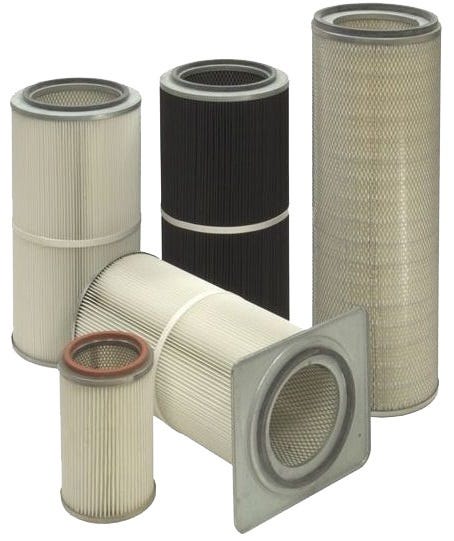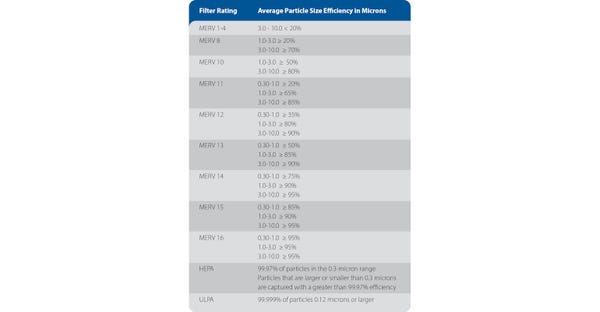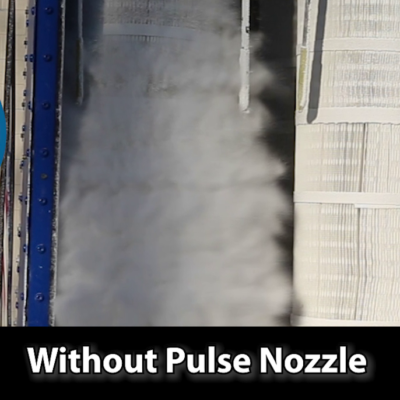Choosing the Right Dust Collector Filters
If you’re not seeing the performance that you would like from your dust collection system, start by looking at your filtration strategy.
June 22, 2023

Daniel Ginzburg, director of aftermarket, RoboVent
Cartridge dust collectors are a practical and reliable choice for most powder and bulk solids applications. Choosing the right filters--and caring for them properly--will greatly enhance the effectiveness and energy efficiency of the dust collection solution.

What Kind of Filters Do You Need?
Powder and bulk solids dust collection covers a broad range of dust types, from ultrafine and potentially toxic chemical compounds to heavy, abrasive mineral powders. Different types of powder and bulk solids dust will require different filtration strategies. Choosing the right dust collector filters depends on the answer to several critical questions, including (but not limited to) the following.
1. What are the physical properties of the dust?
Properties such as particle size distribution and morphology will impact filter selection: dust that is heavy, coarse, and abrasive may require a different type of filter media than ultrafine powder. Abrasive dust may also require specialized engineering of the dust collection system to protect the filters (e.g. baffles or dropout boxes).
2. Is the dust wet, sticky, or oily?
Some dust is naturally oily, sticky, or hygroscopic (attracted to water). If the environment is hot and humid, this will also impact the moisture content of the dust. These factors will impact filter loading and how easy it is to pulse dust off the filters. Specialized filter media and coatings can help extend filter life when collecting moist or sticky dust.
3. What is the volume of dust created?
The higher the dust load, the more filter media (in square feet) will be needed per unit of airflow (cu ft/min). This is known as the air-to-cloth ratio and is an important consideration in dust collector sizing and filter selection.
4. How toxic or hazardous is the dust?
Dust that is highly toxic or hazardous to human health will require a more aggressive filtration strategy than less hazardous dust. The dust collector filters must be able to filter out enough of the material to protect workers and meet Permissible Exposure Limits (PELs) set by the Occupational Safety and Health Administration (OSHA) or other regulatory bodies. For example, the dust collection system may require secondary HEPA filtration or BIBO (bag in/bag out) filter changes.
5. How clean does the production environment need to be?
In addition to protecting humans on the production line, it is important to consider the overall cleanliness needs of the process. If cross-contamination is a concern, or processes must be completed in cleanroom or near-cleanroom conditions, higher-efficiency filtration will be needed.
6. Is the dust combustible or staticky?
Combustible dust requires special care in collection, and that includes selection of filter media. The use of anti-static filter media may be recommended if dust tends to produce static or presents a self-combustion risk.
7. What kind of maintenance is required to maintain the filters?
Maintenance is another important consideration when selecting cartridge filters. Cheaper filters made with lower-quality filter material may cost less upfront, but they will need to be replaced more often as they become loaded or develop microtears and holes from abrasive material (maintenance requirements will also depend on the characteristics of the dust being collected and environmental factors, such as humidity).

Understanding Filtration Efficiency
Filtration efficiency is one of the most important factors to consider when selecting cartridge dust collector filters for powder and bulk solids applications. Two common metrics used to assess filtration efficiency are the Minimum Efficiency Reporting Value (MERV) and High-Efficiency Particulate Air (HEPA) ratings.
MERV Ratings
The MERV rating, set by the American Society of Heating, Refrigerating and Air-Conditioning Engineers (ASHRAE), is a widely used measure of filtration efficiency. MERV ratings range from 1 to 20; a higher MERV rating indicates that the filter is able to capture a higher percentage of particles of various sizes (3–10 microns, 1-3 microns, or 0.3 – 1 microns). Filters rated MERV 17 and above are equivalent to HEPA filtration. Most dust collector cartridge filters are rated between MERV 11 and MERV 16.
HEPA Ratings
HEPA filters--and their even higher-efficiency cousins, Ultra-Low Particulate Air (ULPA) filters--are used when applications require filtration efficiency above MERV 16. To qualify as HEPA by US government standards, an air filter must remove 99.97% of particles that have a size of 0.3 microns. ULPA filters must capture 99.999% of particles 0.12 microns or larger and are used when cleanroom conditions are required. Cartridge dust collectors are sometimes equipped with a HEPA after-filter to collect fine contaminants that make their way past the cartridge filter.

Filtration Efficiency Tradeoffs
While choosing cartridges with the highest filtration efficiency available may seem like an attractive option, there are tradeoffs to consider when selecting higher-efficiency filters.
Cost: Higher-efficiency filter media is generally more costly than lower-efficiency media.
Maintenance: Higher-efficiency filters capture a higher percentage of particulate, which means they may also become loaded more quickly and need to be changed more often (this can be mitigated with proper filter pulsing and a progressive filtration strategy).
Energy efficiency: Higher-efficiency filters have more pressure drop across the filter and require more energy to push air through, especially as they become loaded with fine particulate. This results in higher energy costs for high-efficiency filtration.
Because of these tradeoffs, it does not make sense to select dust collector cartridge filters with a higher efficiency rating than needed by the application. Filter selection will depend on the size of the particulate to be captured and the degree of capture efficiency needed. This will be determined by the cleanliness required by the application and/or the hazard level of the dust; higher filtration efficiency will be needed to meet stringent PELs for toxic or hazardous dust, for example. An engineering partner can help you determine the best filtration efficiency for your application.
Progressive Filtration
Progressive filtration, also known as staged or multi-stage filtration, is a strategy used in dust collection systems where air is passed through a series of filters with increasing filtration efficiency. The concept is to remove the larger particles using less expensive, lower-efficiency filters, and then progressively remove smaller particles in later stages using higher-efficiency filters. This approach has several benefits, including:
Extended filter life for higher-efficiency (and higher-cost) filters
Reduced maintenance requirements
Reduced filter loading and lower energy costs
Improved system efficiency and effectiveness
Powders and bulk materials with a wide range of particle sizes will often benefit from a progressive filtration strategy.
First stage: Heavy, coarse material is removed by an inexpensive intake filter (pre-filter) on the dust collector intake. For applications that produce large volumes of heavy, abrasive dust, a cyclone collector is sometimes used to remove larger, heavier particles before air enters the cartridge dust collector.
Second stage: The cartridge dust collector removes the bulk of mid-size particulate. A medium efficiency-rated cartridge (MERV 13-15) is typically used for this stage.
Third stage: A HEPA after-filter removes remaining fine and ultrafine submicron particulate.
Filter Media Options
Cartridge filters come in various types, each with its own set of properties designed to capture and hold specific kinds of dust particles.
Cellulose: This is a traditional filter media, which is cost-effective and suitable for many standard applications. Cellulose media typically have a MERV rating of around 10-12. However, they are not the most efficient or durable option available, especially for heavy-duty industrial applications.
Blended Cellulose-Polyester: By blending cellulose with synthetic fibers, the filter's durability and moisture resistance can be improved compared to pure cellulose filters. These filters are often used in applications where moisture or high humidity is a concern and have a wider range of MERV ratings (usually 11-16).
Spunbond Polyester: This is a durable filter media that is resistant to harsh conditions, including exposure to certain chemicals, high humidity, and high temperatures. They can also be treated with various coatings to enhance their performance. Some may be washable (up to 2-4 times, depending on the application).
Nanofiber: This filter media is composed of ultra-fine fibers that form a thin layer on the surface of a substrate material (like polyester). The nanofiber layer improves the filter's efficiency in capturing small particles (improving filtration efficiency to the MERV 15+ range), while the substrate provides structural support.
PTFE-Coated: PTFE (Polytetrafluoroethylene) is a type of plastic that can be formed into a thin membrane with very small pores. PTFE-coated filters provide high filtration efficiency and excellent moisture and chemical resistance. They also improve the filter’s ability to shed dust (including hygroscopic or sticky dust), which extends the filter life.
Anti-Static Filters: These filters are designed to reduce the buildup of static electricity, which can be a concern in applications involving combustible dust. They typically feature a special coating or are made from conductive fibers.
The Importance of Filter Quality
The quality of a cartridge filter is a critical factor that directly impacts the performance and efficiency of the dust collection system. High-quality filters not only provide superior filtration performance, but they also tend to last longer, require less maintenance, and provide better overall value in the long run. In addition to looking at the filter media type and filtration efficiency (MERV rating), consider:
Filter construction: Look for filters that are well-constructed with sturdy materials. This includes the filter's end caps, gaskets, and inner and outer liners. High-quality filters are built to withstand heavy use and prevent leaks past the filters.
Pleat design: The pleats in a cartridge filter increase the surface area available for filtration. A high-quality filter will have a consistent and uniform pleat design, which promotes better airflow and dust release during cleaning. Optimal filter spacing makes more of the filter media usable, so each filter lasts longer and captures more particulate. Innovative pleat design also allows more filter media to be packed into a smaller space, which translates to a smaller overall dust collector size per CFM.
Extending the Life of Your Dust Collector Filters
Choosing the right filter for your application will go a long way towards maximizing filter life and optimizing the efficiency of your dust collection system. Proper maintenance and care are also essential to ensure proper performance of your filters. There are several important steps to take:
Installation: Make sure the filters are installed correctly and that the dust collector is sealed properly to prevent leaks.
Filter pulsing: The dust collector should have a filter pulsing mechanism, which periodically pulses excess dust off the filters using compressed air to extend filter life.
Timely filter changes: Don't wait until the filters are completely clogged before replacing them. Operating with overloaded filters can cause damage to the dust collector and reduce its overall efficiency. Monitor pressure drop and replace filters when necessary.
Airflow: Ensure that the dust collector is sized properly to provide adequate airflow for your application. Too much or too little airflow can reduce filtration performance and filter life.
Preventative maintenance: Regular inspection and maintenance of the dust collector system can help identify and correct issues before they lead to major problems. This includes checking filters for leaks, inspecting the cleaning system, and ensuring that the dust collector is operating within its design parameters and maintained in accordance with manufacturer recommendations.

Summary
If you’re not seeing the performance that you would like from your dust collection system, start by looking at your filtration strategy. Changing your filter media, adding pre-filters or after-filters, or optimizing your filter pulsing cycles could make a big difference—and is much cheaper than buying a new dust collector. Don't hesitate to seek expert advice if needed. Remember, the right filtration strategy not only enhances system performance but also promotes a safer and healthier working environment.
Daniel Ginzburg is director of aftermarket, RoboVent (Sterling Heights, MI). For more information, call 877-959-7639 or visit www.robovent.com.
You May Also Like


